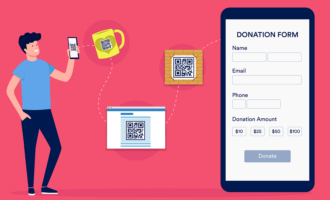When the COVID-19 pandemic first made headlines, nonprofits had to make a flurry of decisions. Many had to cancel events, pause major gift campaigns, and, seemingly overnight, watch as their carefully planned fundraising strategies derailed.
At this point, we’re many months into the pandemic with no foreseeable end in sight. Unfortunately, what has become “the new normal” across society remains a difficult atmosphere for nonprofit fundraising. While everyone adjusts to wearing masks and social distancing, it’s harder to adjust fundraising strategies — something built on strong relationship building — to the changes.
If you haven’t already, it’s time to accept that your nonprofit will continue operating in a pandemic environment for the near future. So it’s time to adjust your fundraising strategy to meet your nonprofit’s goals.
Technology is key to unlocking nonprofit growth. From an effective CRM to innovative mobile app technology, nonprofits are turning to technology to overcome obstacles in their fundraising strategies and reach greater heights than ever before.
With that in mind, we’ve brainstormed four ways that your team can use nonprofit tech to fundraise successfully during these challenging times:
- Bring fundraising events to the virtual sphere.
- Increase convenience for donors with innovative technology.
- Get creative to stay connected during times of disconnection.
- Turn to new fundraising channels to raise revenue.
Are you ready to leverage your tech stack to weather the pandemic? Let’s dive in.
Bring fundraising events to the digital sphere
As the director of your nonprofit’s fundraising program, you likely watched a handful of fundraising events go down the drain during the first quarter of 2020. Whether nationwide peer-to-peer events or major donor galas, these events were suddenly no longer permissible under the mandated social distancing restrictions.
That said, canceling all fundraising events for 2020 isn’t a strong strategy — at least, not one that will raise the funds needed to continue making an impact. Donors love events, both as a way to give back and as a way to build a meaningful connection with your organization.
So how do you continue hosting fundraising events that respect this year’s distancing requirements? Bring them to the digital sphere!
For example, virtual peer-to-peer fundraising events are a powerful way to unite both local and widespread participants to fundraise for your cause.
Let’s take a popular example, a walkathon, to break down the steps of a virtual peer-to-peer event:
- Choose a date and time for your event.
- Equip participants with the tools to raise digital donations (for example, an online giving page) and track the steps they walk (such as a mobile app).
- Encourage participants to solicit donations and pledges from their peers in support of their participation in your event.
- Invite supporters to all walk the same distance, at the same time and on the same day, from their own socially distanced location.
Virtual event capabilities extend beyond peer-to-peer and walkathon-style events. Your nonprofit can hold virtual auctions, galas, and more.
Increase convenience for donors with innovative technology
One way to encourage donors to give to you virtually is to make the process as easy as possible.
Giving during 2020 requires supporters to effectively navigate technology. While some of your donors are already tech savvy, there will likely be an entire demographic of your supporter base that’s unfamiliar with these tools. Giving online might be a big adjustment, so it’s up to you to make that adjustment as smooth as possible.
There are a few ways to ensure you use intuitively designed technology to make this adjustment easy for less tech-savvy donors:
- Use digital forms when needed. Rather than asking donors to print out forms to sign — or download, digitally sign, and submit — simply provide accessible digital forms that are quick and easy to fill out. If you’re hosting any virtual fundraising events, this is key.
- Take engagement mobile. Nonprofit apps are a great way to empower donors to give and participate in events from the convenience of their smartphones. These apps are innovative, and supporters can participate in fundraising events, conduct advocacy efforts, and give to your organization through them.
- Provide a self-serve portal. Encourage donors to update their own communication preferences and financial information as needed through a self-serve portal. Whether donors are adding new billing information, opting into emails, or even changing their recurring giving information, self-serve portals are significantly more convenient than asking your team to make updates on a supporter’s behalf.
With these tech tools, adjusting to socially distanced giving will be easy for your supporters. Plus, it will simplify the process for your team as well.
Get creative to stay connected during times of disconnection
We’ve briefly discussed how effective fundraising requires building strong relationships with supporters. When a donor feels connected to your organization and understands the impact of their support, they’re more likely to give.
So how do you build and maintain those relationships in a world that’s more (physically) disconnected than ever before? Well, you need to get creative.
Consider the following strategies to safely remain connected with supporters during the pandemic:
- Draw on the power of video. Whether you’re hosting a virtual happy hour via videoconferencing or live streaming from your nonprofit’s headquarters, supporters will appreciate the opportunity to see your staff and connect “face to face.”
- Use a variety of communication channels. A multichannel marketing strategy is the best way to ensure you’re reaching each and every supporter. Consider using social media, direct mail, and nonprofit email marketing, as described in this guide, to reach supporters in new and exciting ways.
- Pick up the phone. While some organizations opt for written communications, you can’t overestimate the power of a sincere conversation. Consider calling your organization’s most ardent supporters and asking about how they’re faring during this time.
- Ask for feedback. Consider sending a survey to supporters or sharing an email address specifically designed to receive feedback. Invite supporters to ask any questions they have about the state of your organization, your fundraising efforts, and your mission in light of the pandemic.
With these tips, you’ll not only speak to your supporters but also give them an opportunity to respond. In a society that’s more distant than ever in recent memory, your donors will appreciate the chance to connect.
Turn to new fundraising channels to raise revenue
Even if you have a fully optimized digital giving process, that doesn’t change the fact that many of your supporters may be hard-pressed for expendable income. The pandemic’s effects have stretched far beyond healthcare concerns, and it would come as no surprise if your donors felt the economic effects as well.
With that in mind, it’s a great idea to supplement your regular fundraising revenue with new revenue channels. Consider using the following channels to maximize funding for your organization:
- Corporate giving programs. According to this Double the Donation guide, corporate matching gift programs allow businesses to stretch their philanthropic muscles by matching the donations their employees make to your nonprofit. Consider embedding a matching gift tool on your digital giving form, giving your donors the ability to see if their gift is match-eligible.
- Facebook birthday fundraisers. Social media is a massive channel for fundraising, and Facebook birthday fundraisers alone raise billions on behalf of nonprofits every year. Consider sharing instructions with your donors regarding how they can start their own fundraisers and encouraging those with upcoming birthdays to raise money on their special day.
Technology makes both of these fundraising channels significantly more accessible. Plus, neither requires your donors to give more out of their own pockets to have a positive impact on your organization.
Each of these tech tips can help your organization continue fundraising successfully in 2020. However, we’ll leave you with one last recommendation to improve your efforts going forward:
Prioritize effective data management when diving into these new tech-fueled fundraising efforts.
While the increased need for digital fundraising is new, that doesn’t mean that these giving channels are going to disappear after the pandemic. Incorporating technology will increase your fundraising efficiency. Collecting the data generated by your tech stack will empower your nonprofit to continue optimizing your strategies going forward.
It’s a great idea to work with a nonprofit tech consultant, both to implement your new tech-fueled fundraising solutions and to make sure you collect all the data from the effort. Good luck!























Send Comment: